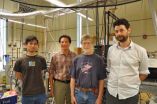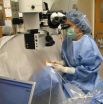(Press-News.org) Health care laws to protect patients' privacy make it nearly impossible for medical device designers to develop and test the safety and usability of medical products by observing use in an actual practitioner-patient setting. As a result, usability errors and hazards may be overlooked, with the potential for devastating consequences. In the recent issue of Ergonomics in Design, human factors/ergonomics researchers found that storytelling as a qualitative research method was a more effective—and stimulating—way for health care practitioners to provide valuable insights during the information-gathering and product development phases.
Storytelling, unlike the more formal interview methods, allows more conversational freedom. Storytellers can provide more detailed information about their personal experiences with a product and recall the unique circumstances associated with each experience. To test this theory, Kim Gausepohl, Woodrow Winchester, James Arthur, and Tonya Smith-Jackson held storytelling and interview sessions with health care practitioners to discuss medical device errors. They found that participants in the storytelling sessions were much more willing to openly discuss HF/E problems that they encountered than were interview session participants.
"Several storytelling participants stayed after the session to chat, and one even followed us to our car to continue chatting," said Gausepohl. "In contrast, no interview participants initiated any after-session chats, and they all appeared to be exhausted at the end, even though they spent the same amount of time in the session as did storytelling participants."
Storytelling as a means to design and develop medical devices has yet to be explored more fully, but Gausepohl and colleagues believe that practitioners' stories could provide useful scenarios to test the usability and safety of products in the absence of observations of product use in real-world settings.
###
The Human Factors and Ergonomics Society is the world's largest nonprofit individual-member, multidisciplinary scientific association for human factors/ergonomics professionals, with more than 4,600 members globally. HFES members include psychologists and other scientists, designers, and engineers, all of whom have a common interest in designing systems and equipment to be safe and effective for the people who operate and maintain them. Watch science news stories about other HF/E topics at the HFES Web site. "Human Factors and Ergonomics: People-Friendly Design Through Science and Engineering"
Plan to attend the HFES 55th Annual Meeting, September 19-23: http://www.hfes.org/web/HFESMeetings/2011annualmeeting.html
Health-care practitioners' stories can aid medical device designers
Storytelling as a data-gathering method may prove more effective than Q&A interviews when designers can’t observe product use in context
2011-07-12
ELSE PRESS RELEASES FROM THIS DATE:
Chicks dig certain types of music
2011-07-12
What accounts for the sounds we like to hear? Is it something about the properties of our auditory systems or brains? Or are such tastes learned? Two-month-old human infants show a preference for consonant, or gentler harmonies over more dissonant or harsher ones. But it's still impossible to know whether that preference is inborn, since the babies may have been exposed to certain sounds, even in utero.
Birds show similar behaviors: they can distinguish between different kinds of sounds and certain species are attracted to certain sounds. But because no one had experimented ...
Even before language, babies learn the world through sounds
2011-07-12
It's not just the words, but the sounds of words that have meaning for us. This is true for children and adults, who can associate the strictly auditory parts of language— vowels produced in the front or the back of the mouth, high or low pitch—with blunt or pointy things, large or small things, fast-moving or long-staying things.
Do the same principles apply for young infants, and not just to things, but also to abstractions? A new study by Marcela Peña, Jacques Mehler, and Marina Nespor, working together at the International School for Advanced Studies, in Trieste, ...
UC Riverside physicists discover new way to produce antimatter-containing atom
2011-07-12
RIVERSIDE, Calif. – Physicists at the University of California, Riverside report that they have discovered a new way to create positronium, an exotic and short-lived atom that could help answer what happened to antimatter in the universe, why nature favored matter over antimatter at the universe's creation.
Positronium is made up of an electron and its antimatter twin, the positron. It has applications in developing more accurate Positron Emission Tomography or PET scans and in fundamental physics research.
Recently, antimatter made headlines when scientists at CERN, ...
More oxygen in eyes of African-Americans may help explain glaucoma risk
2011-07-12
AUDIO:
Optic nerve damage from glaucoma seems to be at least partly related to damage from byproducts of oxygen in the eye. now, measuring oxygen levels during eye surgery, researchers at...
Click here for more information.
Measuring oxygen during eye surgery, investigators at Washington University School of Medicine in St. Louis have discovered a reason that may explain why African-Americans have a higher risk of glaucoma than Caucasians.
They found that oxygen levels ...
Too much sitting may be bad for your health
2011-07-12
San Diego, CA, July 12, 2011 – Lack of physical exercise is often implicated in many disease processes. However, sedentary behavior, or too much sitting, as distinct from too little exercise, potentially could be a new risk factor for disease. The August issue of the American Journal of Preventive Medicine features a collection of articles that addresses many aspects of the problem of sedentary behavior, including the relevant behavioral science that will be needed to evaluate whether initiatives to reduce sitting time can be effective and beneficial.
"Epidemiologic and ...
The metabolic effects of antipsychotic drugs
2011-07-12
07/07/11, Clearwater Beach, FL. Research to be presented at the upcoming annual meeting of the Society for the Study of Ingestive Behavior (SSIB), the foremost society for research into all aspects of eating and drinking behavior, may explain why some antipsychotic drugs can promote overeating, weight gain, and insulin resistance.
Olanzapine, an atypical antipsychotic drug approved by the FDA for the treatment of schizophrenia and bipolar disorder, has been associated with body weight gain and impaired glucose homeostasis in humans and in experimental animals. As part ...
Feeding hormone ghrelin modulates ability of rewarding food to evoke dopamine release
2011-07-12
07/07/11, Clearwater Beach, FL. New research findings to be presented at the upcoming annual meeting of the Society for the Study of Ingestive Behavior (SSIB), the foremost society for research into all aspects of eating and drinking behavior, finds that ghrelin, a natural gut hormone that stimulates feeding, also modulates the ability of tasty food and food-related cues to alter dopamine levels within the striatum, a critical component of the brain's reward system.
Scientists measured dopamine in 'real-time' while rats ate sugar, a highly rewarding food. Administering ...
Molasses extract decreases obesity caused by a high-fat diet
2011-07-12
07/07/11, Clearwater Beach, FL. Experimental results to be presented at the upcoming annual meeting of the Society for the Study of Ingestive Behavior (SSIB), the foremost society for research into all aspects of eating and drinking behavior, suggests that dietary supplementation with molasses extract may provide a novel approach for weight management in humans.
The study, conducted in mice by Richard Weisinger, Ph.D., investigated the impact of adding molasses extract to a high fat diet. Molasses extract is rich in polyphenols, a group of chemical compounds found ...
Caffeine promotes drink flavor preference in adolescents
2011-07-12
07/07/11, Clearwater Beach, FL. Research to be presented at the upcoming annual meeting of the Society for the Study of Ingestive Behavior (SSIB), the foremost society for research into all aspects of eating and drinking behavior, indicates that caffeine added to sugar-sweetened, carbonated beverages teaches adolescents to prefer those beverages. Researchers found that the amount of caffeine added to an unfamiliar beverage was correlated with how much teenagers liked that beverage.
"Soda manufacturers claim that caffeine is added to their products to enhance flavor. ...
New technology allows lenses to change color rapidly
2011-07-12
A University of Connecticut scientist has perfected a method for creating quick-changing, variable colors in films and displays, such as sunglasses, that could lead to the next hot fashion accessory.
The new technology also has captured the interest of the U.S. military as a way to assist soldiers who need to be able to see clearly in rapidly changing environments.
The process for creating the lenses, for which a patent is pending, also is less expensive and less wasteful to manufacturers than previous methods. The findings were published July 7 in the Journal of Materials ...
LAST 30 PRESS RELEASES:
“Gifted word learner” dogs can pick up new words by overhearing their owners’ talk
More data, more sharing can help avoid misinterpreting “smoking gun” signals in topological physics
An illegal fentanyl supply shock may have contributed to a dramatic decline in deaths
Some dogs can learn new words by eavesdropping on their owners
Scientists trace facial gestures back to their source. before a smile appears, the brain has already decided
Is “Smoking Gun” evidence enough to prove scientific discovery?
Scientists find microbes enhance the benefits of trees by removing greenhouse gases
KAIST-Yonsei team identifies origin cells for malignant brain tumor common in young adults
Team discovers unexpected oscillation states in magnetic vortices
How the brain creates facial expressions
Researchers observe gas outflow driven by a jet from an active galactic nucleus
Pitt student finds familiar structure just 2 billion years after the Big Bang
Evidence of cross-regional marine plastic pollution in green sea turtles
Patients with clonal hematopoiesis have increased heart disease risk following cancer treatment
Stem cell therapy for stroke shows how cells find their way in the brain
Environment: Up to 4,700 tonnes of litter flows down the Rhine each year
Maternal vaccine receipt and infant hospital and emergency visits for influenza and pertussis
Interim safety of RSVpreF vaccination during pregnancy
Stem cell engineering breakthrough paves way for next-generation living drugs
California grants $7.4 million to advance gene-edited stem cell therapy for Friedreich’s ataxia
Victoria’s Secret grant backs cutting-edge ovarian cancer research
Research paves the way for safer colonoscopy bowel prep for people with compromised gut health
JMIR Publications and Sweden's National Library announce renewal and expansion of flat-fee unlimited open access partnership for 2026
A new 3D-printed solar cell that’s transparent and color-tunable
IV iron is the cost-effective treatment for women with iron deficiency anemia and heavy menstrual bleeding
Doing good pays off: Environmentally and socially responsible companies drive value and market efficiency
City of Hope and Cellares to automate manufacturing of solid tumor CAR T cell therapy
Short-circuiting pancreatic cancer
Groundbreaking mapping: how many ghost particles all the Milky Way’s stars send towards Earth
JBNU researchers propose hierarchical porous copper nanosheet-based triboelectric nanogenerators
[Press-News.org] Health-care practitioners' stories can aid medical device designersStorytelling as a data-gathering method may prove more effective than Q&A interviews when designers can’t observe product use in context

